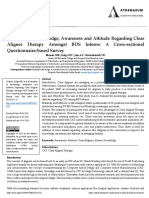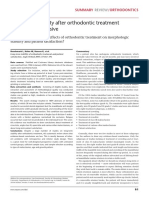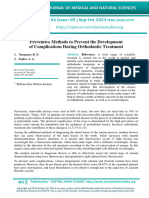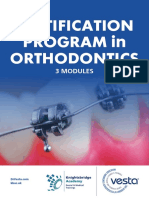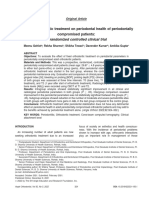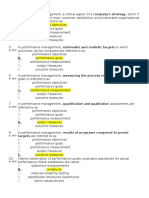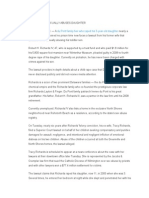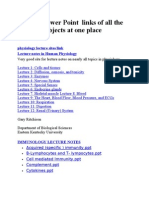Professional Documents
Culture Documents
Assessment of Knowledge and Attitude About Principles and Practices of Orthodontic Treatment Among Dentists and Non-Orthodontic Specialists in Karnataka A Questionnaire Study
Original Title
Copyright
Available Formats
Share this document
Did you find this document useful?
Is this content inappropriate?
Report this DocumentCopyright:
Available Formats
Assessment of Knowledge and Attitude About Principles and Practices of Orthodontic Treatment Among Dentists and Non-Orthodontic Specialists in Karnataka A Questionnaire Study
Copyright:
Available Formats
Volume 7, Issue 11, November – 2022 International Journal of Innovative Science and Research Technology
ISSN No:-2456-2165
Assessment of Knowledge and Attitude about
Principles and Practices of Orthodontic Treatment
among Dentists and Non-Orthodontic Specialists
in Karnataka: A Questionnaire Study
Sharath Kumar Shetty1, Mahesh Kumar Y.2, Harish Gowda K.3
Professor & HOD1, Professor 2, Post Graduate Student3
Department of Orthodontics & Dentofacial Orthopaedics,
K.V.G Dental College & Hospital, Sullia, Karnataka, India
Abstract:- Temporomandibular disorders, 68% (n=246) thought
Introduction: General practitioner dentists and non- that retainers should be worn for 12 months after
orthodontic specialties should have the knowledge of the orthodontic therapy, 58% (n=208) believed that
basic principles and practices of orthodontics in order to orthodontic treatment can be given in periodontally
educate the patients, diagnose their problems correctly compromised patients, 86% (n=309) believed
and for proper referral. orthodontic treatment can be delivered even if the
molars were missing, 96% (n=343) considered calling
Many times, patient might present with a chief an orthodontist for opinion, 87% (n=311) answered
complaint that he/she would not be able to correlate with that they carry out diagnostic orthodontic procedures,
an underlying malocclusion. In that case, it is imperative 84% (n=300) believed orthodontic treatment can be
for the dentist to identify and diagnose the chief cause started before the eruption of all permanent teeth, 88%
which may be an orthodontic cause and then plan a (n=316) said that they will look for malocclusions even
proper referral if the patient presented with some other chief
complaint, 70% (n=250) considered doing orthognathic
Aim:- The objective of the present study is to assess the surgery at patient’s convenience place.
Knowledge and Attitude about Principles and Practices
of Orthodontic Treatment among Dentists and Non- Conclusion:- This study showed that there is good
Orthodontic Specialists in Karnataka. knowledge and Attitude about Principles and Practices
of Orthodontic Treatment among Dentists and Non-
Method:- This study was performed by presenting a Orthodontic Specialists in Karnataka. However, there is
closed questionnaire to a total of 359 participants who a need to increase the knowledge about few things like
were general dental practitioners and non-orthodontic retention after orthodontic treatment and regarding the
specialists. A self-developed questionnaire was requirement of extraction for particular orthodontic
distributed through personal contact and e-mail.The treatment and hence there is a need for an increased
questionnaire survey included a total number of 17 clinically oriented education in the undergraduate
questions out of which 12 questions were formulated to courses and a multi-disciplinary inter department
study the knowledge and 5 questions were formulated to seminar presentations and forums set up for the post-
study the attitude towards orthodontic treatment graduation courses for them to understand the scope of
principles and practices. each other’s specialties.
Result:- Among 359 responders, 74% (n=267) knew that Keywords:- assessment; attitude; knowledge; orthodontic
ideal period to start orthodontic treatment was by treatment.
assessing the Growth period and treating accordingly,
88% (n=316) knew that malocclusions can be treated I. INTRODUCTION
during mixed dentition stage, 94%(n=337) were aware
of functional therapy,75%(n=267) knew that functional Malocclusion has a variety of causes but the outcomes
appliances were best advised during peak of pubertal are quite common including unesthetic appearance, patient
growth period, 94%(n=337) considered functional discomfort, gingival and periodontal problems, difficulty in
therapy as a part of orthodontic treatment when a chewing, speech problems, and etc.1So, a multidisciplinary
patient complains of incompetent lips and proclined approach of patient education is required for them to
teeth, 87%(n=312) were not sure whether extraction of understand the need of orthodontic treatment. Thus, general
teeth during orthodontic treatment, 96% (n=346) practitioner dentists and non-orthodontic specialties ought to
believed habits like mouth breathing or thumb-sucking have the knowledge of the basic principles and practices of
have an effect on the alignment of anterior teeth, 89% orthodontics in order to educate the patients.2Many times
(n=321) believed correcting the malocclusion patient might present with a chief complaint that he/she
influences healthy social living,94% (n=339) believed would not be able to correlate with an underlying
orthodontic therapy can be a part of management of malocclusion. In that case, it is imperative for the dentist to
IJISRT22NOV174 www.ijisrt.com 412
Volume 7, Issue 11, November – 2022 International Journal of Innovative Science and Research Technology
ISSN No:-2456-2165
identify and diagnose the chief cause which may be an 4. Functional appliances are best advised in which
orthodontic cause and then plan a proper referral. 3This study growth stage?
is done with an objectiveto assess the Knowledge and a. Pre pubertal
Attitude about Principles and Practices of Orthodontic b. Peak of pubertal growth
Treatment among Dentists and Non-Orthodontic Specialists c. Post pubertal growth
in Karnataka. d. Growth stage doesn’t matter
5. Do you consider functional therapy as a part of
II. METHODS orthodontic treatment when a patient complains of
incompetent lips and proclined teeth?
A self-developed questionnaire was distributed to a. Yes
general dental practitioners and non-orthodontic specialists b. No
in the state of Karnataka through personal contact and e- 6. Does orthodontic treatment require extraction?
mail. The Ethical approval was obtained from the Ethical a. Yes
committee KVG dental college Sullia, Dakshina Kannada. b. No
To maintain the utmost confidentiality, the personal details c. May be, Sometimes
are not disclosed or circulated anywhere except for between 7. Do habits like mouth breathing or thumb-sucking
the researchers and so the names of the participants are not have an effect on the alignment of anterior teeth?
disclosed in the final report. The inclusion criteria included a. Yes
general practitioner dentists who have completed their b. No
bachelor degree and the Dental specialists other than the 8. Do you believe correcting the malocclusion
orthodontists in the state of Karnataka. Exclusion criteria influences healthy social living?
included dental practitioners who are not currently a. Yes
practicing anywhere. b. No
A sample size of 359 was taken using the following 9. Can orthodontic therapy be a part of management
formula of Temporomandibular disorders?
a. Yes
n= (Z1-α/2) 2 SD2 b. No
10. What is the time duration that retainers should be
d2 worn after orthodontic treatment?
a. 6 months
where, Sd= Standard Devation= 1.87 b. 12 months
c. 24 months
Z1-α/2 = 1.96 at 95% Confidence Interval d. Life long
11. Is orthodontic treatment recommended for patients
d = Absolute Error or Precision- 0.20, having periodontal problems?
Substitutingthe Values, We Get n = 335.75 a. Yes
b. No
To compensate for any possible errors’, the sample c. May be
size was increased to 359 12. Do you deny orthodontic treatment for patients
with missing molar?
The questionnaire survey included a total number of a. Yes
17 questions out of which 12 questions were formulated to b. No
study the knowledge and 5 questions were formulated to 13. Do you call specialist (orthodontist) for an opinion?
study the attitude towards orthodontic treatment principles a. Yes b. No
and practices. 14. Do you carry out diagnostic orthodontic
procedures?
Following were the components of the questionnaire a. Yes
1. What is the ideal period to start orthodontic b. No
treatment? 15. Do you tell your patients to come for orthodontic
a. Mixed dentition period treatment only after eruption of all permanent
b. Permanent dentition period teeth?
c. After all the 3rd Molars are erupted a. Yes
d. To assess the Growth period and treat b. No
accordingly 16. Do you always look for malocclusions on clinical
2. Can malocclusions be treated during mixed examination when patients report with any other
dentition stage? complaint?
a. Yes a. Yes
b. No b. No
3. Are you aware of functional therapy as a part of
Orthodontic treatment?
a. Yes
b. No
IJISRT22NOV174 www.ijisrt.com 413
Volume 7, Issue 11, November – 2022 International Journal of Innovative Science and Research Technology
ISSN No:-2456-2165
17. Where do you refer a patient for orthognathic III. RESULTS
surgery?
a. Perform at own clinic The study included 359 participants and there were 17
b. Refer to dental college questions the results of the study is as follows.
c. Refer to medical college
d. Refer to multispeciality clinic When asked about ideal period to start orthodontic
e. According to patient’s convenience treatment 267(74.4%) answered as by assessing the growth
period and treat accordingly whereas 59 (16.4%) believed
during mixed dentition stage, 25thought during permanent
dentition stage and 8 participants thought after all 3rd molars
are erupted.
Fig. 1: Showing distribution of results for question 1
When asked about can we treat malocclusion during mixed dentition perio
316(88%) answered yes, we can and 43(12%) answered we cannot.
Fig. 2: Showing distribution of results for question 2
337(93.9%) were aware that functional therapy was part of orthodontic treatment 22(6.1%) were not aware of functional therapy.
Fig. 3: Showing distribution of results for question 3
IJISRT22NOV174 www.ijisrt.com 414
Volume 7, Issue 11, November – 2022 International Journal of Innovative Science and Research Technology
ISSN No:-2456-2165
267 answered that functional appliances work best during peak of pubertal growth spurt whereas 71 believed during
prepubertal period 15 believed during post pubertal period and 6 participants believed that growth doesn’t matter.
Fig. 4: Showing distribution of results for question 4
338(94.2%) answered that they consider functional therapy as a part of orthodontic treatment when a patient complains of
incompetent lips and proclined teeth whereas 21 (5.8%) answered they won’t consider.
Fig. 5: Showing distribution of results for question 5
When asked about requirement of extraction during orthodontic treatment 312 (86.9%) answered sometimes its required
sometimes its not required, 32(8.9%) believed extraction is required and 15(4.2%) participants believed extraction is not required.
Fig. 6: Showing distribution of results for question 6
346(96.4%) answered mouth breathing or thumb-sucking have an effect on the alignment of anterior teeth whereas
remaining 13 marked that it has no effect
IJISRT22NOV174 www.ijisrt.com 415
Volume 7, Issue 11, November – 2022 International Journal of Innovative Science and Research Technology
ISSN No:-2456-2165
Fig. 7: Showing distribution of results for question 7
321 believed that correcting the malocclusion influences healthy social living,
Fig. 8: Showing distribution of results for question 8
339 (94%) believed orthodontic therapy can be a part of management of Temporomandibular disorders
Fig. 9: Showing distribution of results for question 9
246 (68% ) thought that retainers should be worn for 12 months after orthodontic therapy, 52(15%) believed that it should
be worn for 6 months, 36(10%) believed it should be worn for 24 months only 25(7%) participants answered that it should be
worn for life long.
IJISRT22NOV174 www.ijisrt.com 416
Volume 7, Issue 11, November – 2022 International Journal of Innovative Science and Research Technology
ISSN No:-2456-2165
Fig. 10: Showing distribution of results for question 10
208 (58%)believed that orthodontic treatment can be given in periodontally compromised patients, 80 (22.3%) believed
they cannot be treated whereas 71(20%) participants answered that they may be treated depending on the severity of
periodontal problem they are having.
Fig. 11: Showing distribution of results for question 11
309 (86%) answered that orthodontic treatment can be delivered even if the molars were missing, but 50 (14%) believed
that orthodontic treatment cannot be given if molars are missing.
Fig. 12: Showing distribution of results for question 12
343 (96%)considered calling an orthodontist for opinion, whereas remaining 4% participants dint bother to call an
orthodontist for opinion.
IJISRT22NOV174 www.ijisrt.com 417
Volume 7, Issue 11, November – 2022 International Journal of Innovative Science and Research Technology
ISSN No:-2456-2165
Fig. 13: Showing distribution of results for question 13
311 (87%)answered that they carry out diagnostic orthodontic procedures,
Fig. 14 : Showing distribution of results for question 14
300 (84%) believed that orthodontic treatment can be started before the eruption of all permanent teeth whereas
remaining 59 (16%) believed that orthodontic treatment should be started only after all permanent teeth are erupted.
Fig. 15: Showing distribution of results for question 15
316 (88%)said that they will look for malocclusions even if the patient presented with some other chief complaint
IJISRT22NOV174 www.ijisrt.com 418
Volume 7, Issue 11, November – 2022 International Journal of Innovative Science and Research Technology
ISSN No:-2456-2165
Fig. 16: Showing distribution of results for question 16
250 (70%) considered doing orthognathic surgery at patient’s convenience place, whereas 71 (20%) consider referring
patient to a dental college, 17 (5%) referred to a multispeciality clinic, 13(3.6%) referred to medical college and 8 (2%)
participants believed that they can do it at their own clinic.
Fig. 17: Showing distribution of results for question 17
IV. DISCUSSION 1716 participants in Saudi Arabia showed similar results of
knowledge and attitude amongst the general practitioner
Malocclusion is a common dental problem running at dentists and specialists.7Many other studies have also been
second number after the dental caries worldwide. 4 Dental done on the knowledge of key parameters of malocclusion
malocclusion can have a plethora of implications and the in many parts of the world.8,9 Many of these studies support
most common being on facial aesthetics. Many associated the fact that dental graduates do not have an ample
problems also include periodontal problems, difficulty in knowledge of basic malocclusion concept. 10 A unique study
mastication, speech, swallowing, TMJ problems, associated was done in Ireland in which a survey was done among the
habit development, etc.5 Many a times, patients come to the dental practitioners about the undergraduate orthodontic
dentists with one of the associated problems as the chief training that they have had and the extent to which they
complaint and at that time, it is imperative for the dentist to apply it in their practice. The results showed a 54% of
recognize the key cause and understand the need for positive response about the academic knowledge. About
orthodontic treatment.6The present study focuses on the 60% of them said they could handle orthodontic
knowledge of dental practitioners both general and non- emergencies. And 70% aspired to go for higher education in
orthodontic specialties towards the basic principles and this field.11The present study is just the first step towards a
practices of orthodontic treatment. Our study shows that bigger question. The end goal is to make sure the dental
there is better understanding about orthodontic basic graduates have enough knowledge so that a proper referral
principles and practices among the general dental of such cases can be made to an orthodontist in time.
practitioners and non -orthodontic specialists. But still there However, the limitation of this study is the geographic area
is a need to understand basic of orthodontics among many covered and the sample as it was a convenient sample. More
dentists who are lacking basic knowledge even to diagnose studies done in this niche would potentiate the findings and
an orthodontic problem.In a study done by Alnusayri on help in acquiring better evidence-based conclusion.
IJISRT22NOV174 www.ijisrt.com 419
Volume 7, Issue 11, November – 2022 International Journal of Innovative Science and Research Technology
ISSN No:-2456-2165
V. CONCLUSIONS [9.] King GJ, McGorray SP, Wheeler TT, Dolce C,
Taylor M. Comparison of peer assessment ratings
This study showed that there is good knowledge and (PAR) from 1-phase and 2-phase treatments protocols
Attitude about Principles and Practices of Orthodontic of Class II malocclusion. Am J Orthod Dentofacial
Treatment among Dentists and Non-Orthodontic Specialists Orthop. 2003;123(5):489-96. [PubMed | Full Text |
in Karnataka. But still there is a need to understand basic of DOI]
orthodontics among many dentists who are lacking basic [10.] Koroluk LD, Tulloch JF, Phillips C. Incisor trauma
knowledge even to diagnose an orthodontic problem. and early treatment for Class II Division 1
However, there is a need to increase the knowledge about malocclusion. Am J Orthod Dentofacial Orthop.
few things like retention after orthodontic treatment and 2003;123(2):117-25. [PubMed | Full Text | DOI]
regarding the requirement of extraction for particular [11.] Fleming PS, Dowling PA. A survey of undergraduate
orthodontic treatment and hence there is a need for an orthodontic training and orthodontic practices by
increased clinically oriented education in the undergraduate general dental practitioners. J Ir Dent Assoc. 2005
courses and a multi-disciplinary inter department seminar Summer;51(2):68-72. [PubMed | Full Text]
presentations and forums set up for the post-graduation
courses for them to understand the scope of each other’s
specialties.
REFERENCES
[1.] Siddegowda R, Rani MS. An epidemiological survey
on awareness towards orthodontic treatment in South
Indian school children. Open J Dent Oral Med.
2013;1:5-8. [Full Text | DOI]
[2.] Sastri MR, Tanpure VR, Palagi FB, Shinde SK,
Ladhe K, Polepalle T. Study of the Knowledge and
Attitude about Principles and Practices of
Orthodontic Treatment among General Dental
Practitioners and Non-orthodontic Specialties. J Int
Oral Health. 2015;7(3):44–8. [PubMed]
[3.] Niveda S, Saravana D. A survey of the knowledge,
attitude and awareness of principles and practices in
orthodontics among general dentists and
nonorthodontic specialists. IOSR J Dent Med Sci.
2014;13(1):44–6. [Full Text]
[4.] Aldrees AM, Tashkandi NE, Al Wanis AA, Al
Sanouni MS, Al-Hamlan NH. Orthodontic treatment
and referral patterns: A survey of pediatric dentists,
general practitioners, and orthodontists. Saudi Dent J.
2015;27(1):30-9. [PubMed | DOI]
[5.] Dhanyasi AK, Mahobia Y, Agarwal APP, et al.
Orthodontic Treatment Provided by General Dentists
with Different Types of Appliances in Chattishgarh,
India. J Clin Diagn Res. 2015;9(6): ZC20–2.
[PubMed | Full Text | DOI]
[6.] Berk NW, Bush HD, Cavalier J, Kapur R, Studen-
Pavlovich D, Sciote J, et al. Perception of orthodontic
treatment need: opinion comparisons of orthodontists,
pediatric dentists, and general practitioners. J Orthod.
2002;29(4):287-91. [PubMed | Full Text | DOI]
[7.] Alnusayri MO, Alnezi KKK, Patil SR, Aeleni KR,
Rao KA. Knowledge and attitude regarding principles
and practices of orthodontic treatment among general
dental practitioners and nonorthodontic specialists of
Saudi Arabia: A preliminary study. J Res Med Dent
Sci. 2017;5(3):59-62. [Full Text | DOI]
[8.] Canavarro C. et al. Assessment of the orthodontic
knowledge demonstrated by dental school
undergraduates: recognizing the key features of
Angle Class II, Division 1 malocclusion. Dental Press
J Orthod. 2012 Jan-Feb;17(1):52.1-10. [Full Text
DOI]
IJISRT22NOV174 www.ijisrt.com 420
You might also like
- Esthetic Oral Rehabilitation with Veneers: A Guide to Treatment Preparation and Clinical ConceptsFrom EverandEsthetic Oral Rehabilitation with Veneers: A Guide to Treatment Preparation and Clinical ConceptsRichard D. TrushkowskyNo ratings yet
- Evaluation of Knowledge Awareness and Attitude Regarding Clear Aligner Therapy Amongst BDS Interns A Cross Sectional Questionnaire Based SurveyDocument12 pagesEvaluation of Knowledge Awareness and Attitude Regarding Clear Aligner Therapy Amongst BDS Interns A Cross Sectional Questionnaire Based SurveyAthenaeum Scientific PublishersNo ratings yet
- Journal Dental Implant 1Document5 pagesJournal Dental Implant 1Faiqotul KumalaNo ratings yet
- Knowledge and Awareness Among Dental Students About Choice of Complete Denture Occlusion in Edentulous PatientDocument7 pagesKnowledge and Awareness Among Dental Students About Choice of Complete Denture Occlusion in Edentulous PatientInternational Journal of Innovative Science and Research TechnologyNo ratings yet
- EJMCM - Volume 7 - Issue 4 - Pages 1689-1693Document5 pagesEJMCM - Volume 7 - Issue 4 - Pages 1689-1693Tanushree JainNo ratings yet
- Jioh 7 144Document4 pagesJioh 7 144Goutam NookalaNo ratings yet
- Managing The Developing Occlusion: A Guide For Dental PractitionersDocument16 pagesManaging The Developing Occlusion: A Guide For Dental PractitionersHabeeb AL-AbsiNo ratings yet
- Table Top Tooth Wear - A Systematic Review of Treatment OptionsDocument8 pagesTable Top Tooth Wear - A Systematic Review of Treatment OptionsZardasht NajmadineNo ratings yet
- Dental Malpractice, The Odds in Dental TreatmentDocument6 pagesDental Malpractice, The Odds in Dental TreatmentMihaela EmmaNo ratings yet
- Surgical Guidelines For Dental Implant Placement: British Dental Journal September 2006Document15 pagesSurgical Guidelines For Dental Implant Placement: British Dental Journal September 2006Louis HutahaeanNo ratings yet
- Implant 0Document1 pageImplant 0Dentist HereNo ratings yet
- Linea MediaDocument11 pagesLinea Mediavane dzNo ratings yet
- Treatment Standards: 180 N. Stetson Ave. Suite 1500 Chicago, IL 60601Document26 pagesTreatment Standards: 180 N. Stetson Ave. Suite 1500 Chicago, IL 60601Mufidah NurulNo ratings yet
- CAO Orthodontic Assistant Permit ManualDocument68 pagesCAO Orthodontic Assistant Permit ManualjustforrandommiscNo ratings yet
- Long-Term Stability After Orthodontic Treatment Remains InconclusiveDocument2 pagesLong-Term Stability After Orthodontic Treatment Remains InconclusiveHabeeb AL-AbsiNo ratings yet
- Assessment of Awareness of Post Orthodontic Retention Among Medical Students A Questionnaire StudyDocument9 pagesAssessment of Awareness of Post Orthodontic Retention Among Medical Students A Questionnaire StudyInternational Journal of Innovative Science and Research TechnologyNo ratings yet
- BP - DevelopDentition AapdDocument17 pagesBP - DevelopDentition AapdAJPEDO LIFENo ratings yet
- Cross Sectional ProstoDocument7 pagesCross Sectional ProstoHafidh AkbarNo ratings yet
- An Introduction To Removable Denture Prosthodontics - Churchill Livingstone September 1983Document231 pagesAn Introduction To Removable Denture Prosthodontics - Churchill Livingstone September 1983Syrk12100% (2)
- Awareness of Interdental Aids and Chemical Plaque Control Among Dental StudentsDocument7 pagesAwareness of Interdental Aids and Chemical Plaque Control Among Dental StudentsInternational Journal of Innovative Science and Research TechnologyNo ratings yet
- Treatment Planning For Implant Dentistry Waterpik Michael Tischler DdsDocument12 pagesTreatment Planning For Implant Dentistry Waterpik Michael Tischler DdsSylwia CebulaNo ratings yet
- Management of The Developing Dentition and Occlusion in Pediatric DentistryDocument18 pagesManagement of The Developing Dentition and Occlusion in Pediatric DentistryPAULA ANDREA RAMIREZ ALARCONNo ratings yet
- Phadraig Et Al 2019 - Systematic DesensitizationDocument16 pagesPhadraig Et Al 2019 - Systematic DesensitizationCarlindo e CarlindoNo ratings yet
- Roots 3 - 2016Document44 pagesRoots 3 - 2016OvidiuNo ratings yet
- CD CareDocument8 pagesCD CareAkshayNo ratings yet
- Use of Short Term Orthodontics by The Specialist OrthodontistDocument5 pagesUse of Short Term Orthodontics by The Specialist OrthodontistPaul HartingNo ratings yet
- Preventive Methods To Prevent The Development of Complications During Orthodontic TreatmentDocument6 pagesPreventive Methods To Prevent The Development of Complications During Orthodontic TreatmentCentral Asian StudiesNo ratings yet
- Destiny and DevilDocument177 pagesDestiny and DevilSrinivasan NarasimhanNo ratings yet
- Bds PDFDocument227 pagesBds PDFAiswaryaNo ratings yet
- Certification Program in Orthodontics: 3 ModulesDocument14 pagesCertification Program in Orthodontics: 3 ModulesAbdelhamid MohamedNo ratings yet
- G DevelopDentition PDFDocument13 pagesG DevelopDentition PDFTalita Varianty RahmahNo ratings yet
- 3320 PDFDocument7 pages3320 PDFLouis HutahaeanNo ratings yet
- Immediate Denture A ReviewDocument5 pagesImmediate Denture A ReviewAswathi RaghuthamanNo ratings yet
- Clinical Effectiveness of Clear AlignersDocument12 pagesClinical Effectiveness of Clear AlignersOscar GuerreroNo ratings yet
- Strategic Considerations in Treatment Planning Deciding When To Treat, Extract, or Replace A Questionable Tooth PDFDocument12 pagesStrategic Considerations in Treatment Planning Deciding When To Treat, Extract, or Replace A Questionable Tooth PDFItzel Marquez100% (1)
- Discolored Non-Vital Teeth: Determinants of Treatment Options and Dentists' Knowledge of Precautionary MeasuresDocument8 pagesDiscolored Non-Vital Teeth: Determinants of Treatment Options and Dentists' Knowledge of Precautionary MeasuresIQRAINI BALQISNo ratings yet
- Ethics 2Document3 pagesEthics 2sandeep lachhwaniNo ratings yet
- BP DevelopdentitionDocument18 pagesBP DevelopdentitionShakh ShakhNo ratings yet
- Perio-Prosthodontics Considerations in Removable Partial Denture: The Role of The ProsthodontistDocument9 pagesPerio-Prosthodontics Considerations in Removable Partial Denture: The Role of The ProsthodontistAira Grace PadillaNo ratings yet
- Dental Floss Concept and Use Among The UndergraduaDocument5 pagesDental Floss Concept and Use Among The Undergraduamdasif kiresurNo ratings yet
- Full Denture ProstheticDocument6 pagesFull Denture ProstheticAndykaYayanSetiawanNo ratings yet
- BBBFDocument3 pagesBBBFSkAliHassanNo ratings yet
- 1.1 Original ResearchDocument8 pages1.1 Original ResearchNovita RNo ratings yet
- Prosthodontic Treatment Planning Current Practice Principles and TechniquesDocument4 pagesProsthodontic Treatment Planning Current Practice Principles and TechniquesZiad RabieNo ratings yet
- Online Only Abstracts - YmodDocument5 pagesOnline Only Abstracts - Ymodakshantz ekkaNo ratings yet
- How Accurate Is Invisalign in Nonextraction Cases? Are Predicted Tooth Positions Achieved?Document7 pagesHow Accurate Is Invisalign in Nonextraction Cases? Are Predicted Tooth Positions Achieved?Mirza GlusacNo ratings yet
- 620 Implant Guide WebDocument8 pages620 Implant Guide WebFabián SajamaNo ratings yet
- Patient's Expectation of Orthodontic Treatment at A Tertiary Health Facility in Lagos, NigeriaDocument6 pagesPatient's Expectation of Orthodontic Treatment at A Tertiary Health Facility in Lagos, NigeriadochetNo ratings yet
- Ortho Guidelines-2008 AAODocument43 pagesOrtho Guidelines-2008 AAOThaiHuyThanhNo ratings yet
- How Accurate is Invisalign in Nonextraction CasesDocument7 pagesHow Accurate is Invisalign in Nonextraction CasesCLAUDIA PATRICIA ROSALES BASANTENo ratings yet
- Saudi Dental Patients Attitude Towards Esthetic Dental Treatment at Ksu, College of Dentistry, RiyadhDocument4 pagesSaudi Dental Patients Attitude Towards Esthetic Dental Treatment at Ksu, College of Dentistry, RiyadhSARA BUARISHNo ratings yet
- BBRC 188Document6 pagesBBRC 188Egga AndiniNo ratings yet
- Ecde 18 01005 PDFDocument14 pagesEcde 18 01005 PDFJawad TariqNo ratings yet
- Parameters Deciding Orthognathic Surgery or Camouflage? - A ReviewDocument8 pagesParameters Deciding Orthognathic Surgery or Camouflage? - A ReviewDr. Sagar S BhatNo ratings yet
- Pothukuchi 2006Document6 pagesPothukuchi 2006Carmo AunNo ratings yet
- Orthognathicsurgeryand Orthodontics: Inadequate Planning Leading To Complications or Unfavorable ResultsDocument12 pagesOrthognathicsurgeryand Orthodontics: Inadequate Planning Leading To Complications or Unfavorable ResultsJason LeeNo ratings yet
- E PerioTherapyDocument5 pagesE PerioTherapyIova Elena-corinaNo ratings yet
- 2022 Orto X PerioDocument9 pages2022 Orto X PerioKatia ValNo ratings yet
- KushalsArticle 170Document4 pagesKushalsArticle 170Mihaela TuculinaNo ratings yet
- Useof International Caries Detectionand Assessment Systemina National Health ServiceDocument9 pagesUseof International Caries Detectionand Assessment Systemina National Health Serviceأمال داودNo ratings yet
- Parastomal Hernia: A Case Report, Repaired by Modified Laparascopic Sugarbaker TechniqueDocument2 pagesParastomal Hernia: A Case Report, Repaired by Modified Laparascopic Sugarbaker TechniqueInternational Journal of Innovative Science and Research TechnologyNo ratings yet
- Smart Health Care SystemDocument8 pagesSmart Health Care SystemInternational Journal of Innovative Science and Research TechnologyNo ratings yet
- Visual Water: An Integration of App and Web to Understand Chemical ElementsDocument5 pagesVisual Water: An Integration of App and Web to Understand Chemical ElementsInternational Journal of Innovative Science and Research TechnologyNo ratings yet
- Air Quality Index Prediction using Bi-LSTMDocument8 pagesAir Quality Index Prediction using Bi-LSTMInternational Journal of Innovative Science and Research TechnologyNo ratings yet
- Smart Cities: Boosting Economic Growth through Innovation and EfficiencyDocument19 pagesSmart Cities: Boosting Economic Growth through Innovation and EfficiencyInternational Journal of Innovative Science and Research TechnologyNo ratings yet
- Parkinson’s Detection Using Voice Features and Spiral DrawingsDocument5 pagesParkinson’s Detection Using Voice Features and Spiral DrawingsInternational Journal of Innovative Science and Research TechnologyNo ratings yet
- Predict the Heart Attack Possibilities Using Machine LearningDocument2 pagesPredict the Heart Attack Possibilities Using Machine LearningInternational Journal of Innovative Science and Research TechnologyNo ratings yet
- Impact of Silver Nanoparticles Infused in Blood in a Stenosed Artery under the Effect of Magnetic Field Imp. of Silver Nano. Inf. in Blood in a Sten. Art. Under the Eff. of Mag. FieldDocument6 pagesImpact of Silver Nanoparticles Infused in Blood in a Stenosed Artery under the Effect of Magnetic Field Imp. of Silver Nano. Inf. in Blood in a Sten. Art. Under the Eff. of Mag. FieldInternational Journal of Innovative Science and Research TechnologyNo ratings yet
- An Analysis on Mental Health Issues among IndividualsDocument6 pagesAn Analysis on Mental Health Issues among IndividualsInternational Journal of Innovative Science and Research TechnologyNo ratings yet
- Compact and Wearable Ventilator System for Enhanced Patient CareDocument4 pagesCompact and Wearable Ventilator System for Enhanced Patient CareInternational Journal of Innovative Science and Research TechnologyNo ratings yet
- Implications of Adnexal Invasions in Primary Extramammary Paget’s Disease: A Systematic ReviewDocument6 pagesImplications of Adnexal Invasions in Primary Extramammary Paget’s Disease: A Systematic ReviewInternational Journal of Innovative Science and Research TechnologyNo ratings yet
- Terracing as an Old-Style Scheme of Soil Water Preservation in Djingliya-Mandara Mountains- CameroonDocument14 pagesTerracing as an Old-Style Scheme of Soil Water Preservation in Djingliya-Mandara Mountains- CameroonInternational Journal of Innovative Science and Research TechnologyNo ratings yet
- Exploring the Molecular Docking Interactions between the Polyherbal Formulation Ibadhychooranam and Human Aldose Reductase Enzyme as a Novel Approach for Investigating its Potential Efficacy in Management of CataractDocument7 pagesExploring the Molecular Docking Interactions between the Polyherbal Formulation Ibadhychooranam and Human Aldose Reductase Enzyme as a Novel Approach for Investigating its Potential Efficacy in Management of CataractInternational Journal of Innovative Science and Research TechnologyNo ratings yet
- Insights into Nipah Virus: A Review of Epidemiology, Pathogenesis, and Therapeutic AdvancesDocument8 pagesInsights into Nipah Virus: A Review of Epidemiology, Pathogenesis, and Therapeutic AdvancesInternational Journal of Innovative Science and Research TechnologyNo ratings yet
- Harnessing Open Innovation for Translating Global Languages into Indian LanuagesDocument7 pagesHarnessing Open Innovation for Translating Global Languages into Indian LanuagesInternational Journal of Innovative Science and Research TechnologyNo ratings yet
- The Relationship between Teacher Reflective Practice and Students Engagement in the Public Elementary SchoolDocument31 pagesThe Relationship between Teacher Reflective Practice and Students Engagement in the Public Elementary SchoolInternational Journal of Innovative Science and Research TechnologyNo ratings yet
- Investigating Factors Influencing Employee Absenteeism: A Case Study of Secondary Schools in MuscatDocument16 pagesInvestigating Factors Influencing Employee Absenteeism: A Case Study of Secondary Schools in MuscatInternational Journal of Innovative Science and Research TechnologyNo ratings yet
- Dense Wavelength Division Multiplexing (DWDM) in IT Networks: A Leap Beyond Synchronous Digital Hierarchy (SDH)Document2 pagesDense Wavelength Division Multiplexing (DWDM) in IT Networks: A Leap Beyond Synchronous Digital Hierarchy (SDH)International Journal of Innovative Science and Research TechnologyNo ratings yet
- Diabetic Retinopathy Stage Detection Using CNN and Inception V3Document9 pagesDiabetic Retinopathy Stage Detection Using CNN and Inception V3International Journal of Innovative Science and Research TechnologyNo ratings yet
- Advancing Healthcare Predictions: Harnessing Machine Learning for Accurate Health Index PrognosisDocument8 pagesAdvancing Healthcare Predictions: Harnessing Machine Learning for Accurate Health Index PrognosisInternational Journal of Innovative Science and Research TechnologyNo ratings yet
- Auto Encoder Driven Hybrid Pipelines for Image Deblurring using NAFNETDocument6 pagesAuto Encoder Driven Hybrid Pipelines for Image Deblurring using NAFNETInternational Journal of Innovative Science and Research TechnologyNo ratings yet
- Formulation and Evaluation of Poly Herbal Body ScrubDocument6 pagesFormulation and Evaluation of Poly Herbal Body ScrubInternational Journal of Innovative Science and Research TechnologyNo ratings yet
- The Utilization of Date Palm (Phoenix dactylifera) Leaf Fiber as a Main Component in Making an Improvised Water FilterDocument11 pagesThe Utilization of Date Palm (Phoenix dactylifera) Leaf Fiber as a Main Component in Making an Improvised Water FilterInternational Journal of Innovative Science and Research TechnologyNo ratings yet
- The Making of Object Recognition Eyeglasses for the Visually Impaired using Image AIDocument6 pagesThe Making of Object Recognition Eyeglasses for the Visually Impaired using Image AIInternational Journal of Innovative Science and Research TechnologyNo ratings yet
- The Impact of Digital Marketing Dimensions on Customer SatisfactionDocument6 pagesThe Impact of Digital Marketing Dimensions on Customer SatisfactionInternational Journal of Innovative Science and Research TechnologyNo ratings yet
- Electro-Optics Properties of Intact Cocoa Beans based on Near Infrared TechnologyDocument7 pagesElectro-Optics Properties of Intact Cocoa Beans based on Near Infrared TechnologyInternational Journal of Innovative Science and Research TechnologyNo ratings yet
- A Survey of the Plastic Waste used in Paving BlocksDocument4 pagesA Survey of the Plastic Waste used in Paving BlocksInternational Journal of Innovative Science and Research TechnologyNo ratings yet
- Cyberbullying: Legal and Ethical Implications, Challenges and Opportunities for Policy DevelopmentDocument7 pagesCyberbullying: Legal and Ethical Implications, Challenges and Opportunities for Policy DevelopmentInternational Journal of Innovative Science and Research TechnologyNo ratings yet
- Comparatively Design and Analyze Elevated Rectangular Water Reservoir with and without Bracing for Different Stagging HeightDocument4 pagesComparatively Design and Analyze Elevated Rectangular Water Reservoir with and without Bracing for Different Stagging HeightInternational Journal of Innovative Science and Research TechnologyNo ratings yet
- Design, Development and Evaluation of Methi-Shikakai Herbal ShampooDocument8 pagesDesign, Development and Evaluation of Methi-Shikakai Herbal ShampooInternational Journal of Innovative Science and Research Technology100% (3)
- Wrap Book A4Document27 pagesWrap Book A4doscribe100% (1)
- Ventilation System Comparison - Constant Air Volume (CAV) and Variable Air Volume (VAV)Document15 pagesVentilation System Comparison - Constant Air Volume (CAV) and Variable Air Volume (VAV)ankurNo ratings yet
- Animal Names in English and Telugu - 20170912 - 182216545Document17 pagesAnimal Names in English and Telugu - 20170912 - 182216545karimulla goraNo ratings yet
- SorghumDocument13 pagesSorghumMohaajanan AliNo ratings yet
- NeseritideDocument28 pagesNeseritideNavojit Chowdhury100% (1)
- Work Immersion PortfolioDocument15 pagesWork Immersion PortfolioKaye Irish RosauroNo ratings yet
- Kshitija's ResumeDocument1 pageKshitija's ResumeNavinNo ratings yet
- RR No. 6-2015 PDFDocument5 pagesRR No. 6-2015 PDFErlene CompraNo ratings yet
- Engineering ManualDocument27 pagesEngineering ManualThousif Rahman67% (3)
- Silver Rain Svetlana Perevalova PDFDocument9 pagesSilver Rain Svetlana Perevalova PDFAndrea Koumarian100% (1)
- BInggrisDocument19 pagesBInggrisanwar318No ratings yet
- The Strange ICA Stones of PeruDocument31 pagesThe Strange ICA Stones of PeruRoman Aleshkevich100% (1)
- Veterinarian Careers Projected Strong GrowthDocument6 pagesVeterinarian Careers Projected Strong Growthnmann7100% (1)
- Curriculum DesignDocument20 pagesCurriculum DesignRose Glaire Alaine TabraNo ratings yet
- Nanotechnology Presentation Covers Medicine, Electronics and EnergyDocument13 pagesNanotechnology Presentation Covers Medicine, Electronics and EnergypravinfoodNo ratings yet
- Barbecue Sauce HomadeDocument22 pagesBarbecue Sauce HomadeLiza NasrNo ratings yet
- Research ProposalDocument10 pagesResearch ProposalRonNo ratings yet
- Chapter 8Document8 pagesChapter 8Melissa NagyNo ratings yet
- GER Bangladesh EngDocument12 pagesGER Bangladesh Engfarhan.anjum20032004No ratings yet
- ETR - Part C - Course SyllabusDocument26 pagesETR - Part C - Course SyllabusDon JubacNo ratings yet
- Dupont Heir Sexually Abuses DaughterDocument3 pagesDupont Heir Sexually Abuses DaughterJuandelaCruzNo ratings yet
- Constance Carroll Cosmetics) Final.1Document4 pagesConstance Carroll Cosmetics) Final.1api-26027438100% (1)
- Iupac 1Document15 pagesIupac 1Mayur Kumar GargNo ratings yet
- Concrete Pump Hose TDSDocument2 pagesConcrete Pump Hose TDSAlaa Abu KhurjNo ratings yet
- Lab Manual - Skull Bones - English - Student - Fill inDocument6 pagesLab Manual - Skull Bones - English - Student - Fill inthejaskumar2026No ratings yet
- Grade 5. Unit 15Document6 pagesGrade 5. Unit 15Đình ThuậnNo ratings yet
- Medical Power PointDocument124 pagesMedical Power PointPhysiology by Dr Raghuveer75% (4)
- Volcanic Eruption Types and ProcessDocument18 pagesVolcanic Eruption Types and ProcessRosemarie Joy TanioNo ratings yet
- Codex CRD26Document9 pagesCodex CRD26arely svetlana gaspar badilloNo ratings yet
- Report On PantaloonsDocument63 pagesReport On PantaloonsKashish AroraNo ratings yet

